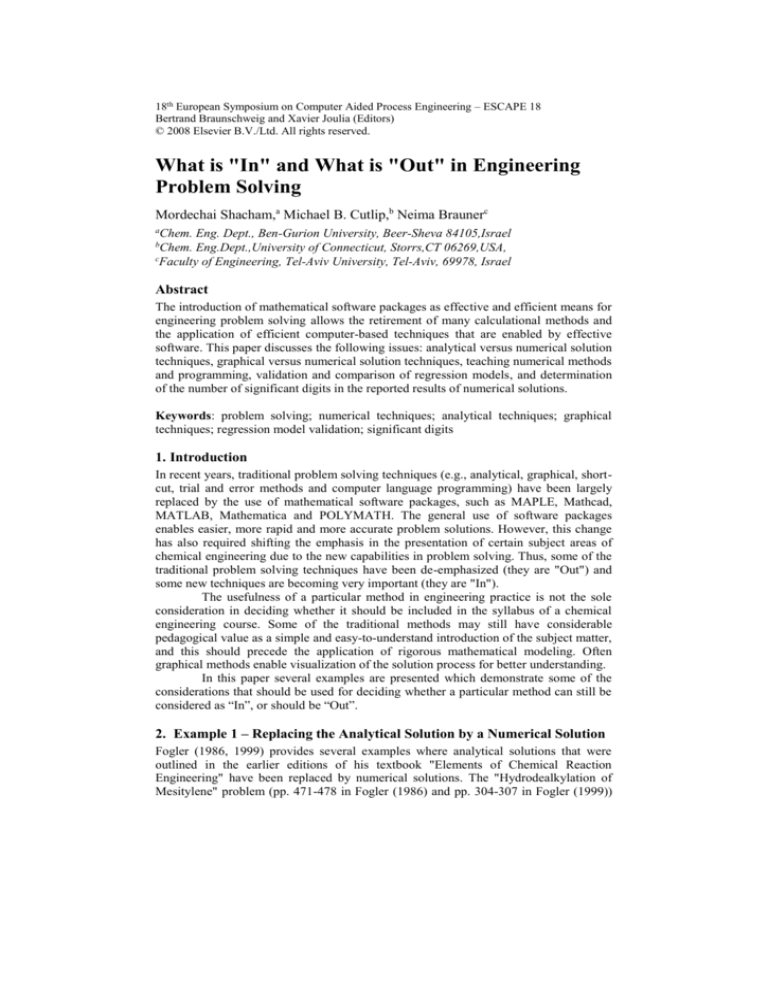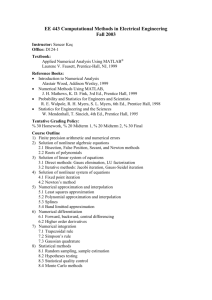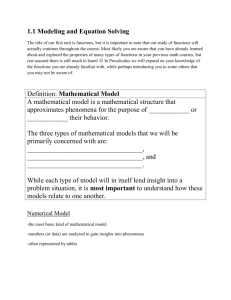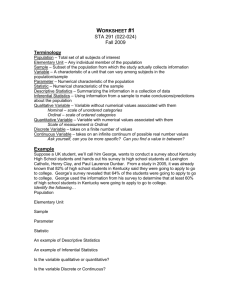
18th European Symposium on Computer Aided Process Engineering – ESCAPE 18
Bertrand Braunschweig and Xavier Joulia (Editors)
© 2008 Elsevier B.V./Ltd. All rights reserved.
What is "In" and What is "Out" in Engineering
Problem Solving
Mordechai Shacham,a Michael B. Cutlip,b Neima Braunerc
a
Chem. Eng. Dept., Ben-Gurion University, Beer-Sheva 84105,Israel
Chem. Eng.Dept.,University of Connecticut, Storrs,CT 06269,USA,
c
Faculty of Engineering, Tel-Aviv University, Tel-Aviv, 69978, Israel
b
Abstract
The introduction of mathematical software packages as effective and efficient means for
engineering problem solving allows the retirement of many calculational methods and
the application of efficient computer-based techniques that are enabled by effective
software. This paper discusses the following issues: analytical versus numerical solution
techniques, graphical versus numerical solution techniques, teaching numerical methods
and programming, validation and comparison of regression models, and determination
of the number of significant digits in the reported results of numerical solutions.
Keywords: problem solving; numerical techniques; analytical techniques; graphical
techniques; regression model validation; significant digits
1. Introduction
In recent years, traditional problem solving techniques (e.g., analytical, graphical, shortcut, trial and error methods and computer language programming) have been largely
replaced by the use of mathematical software packages, such as MAPLE, Mathcad,
MATLAB, Mathematica and POLYMATH. The general use of software packages
enables easier, more rapid and more accurate problem solutions. However, this change
has also required shifting the emphasis in the presentation of certain subject areas of
chemical engineering due to the new capabilities in problem solving. Thus, some of the
traditional problem solving techniques have been de-emphasized (they are "Out") and
some new techniques are becoming very important (they are "In").
The usefulness of a particular method in engineering practice is not the sole
consideration in deciding whether it should be included in the syllabus of a chemical
engineering course. Some of the traditional methods may still have considerable
pedagogical value as a simple and easy-to-understand introduction of the subject matter,
and this should precede the application of rigorous mathematical modeling. Often
graphical methods enable visualization of the solution process for better understanding.
In this paper several examples are presented which demonstrate some of the
considerations that should be used for deciding whether a particular method can still be
considered as “In”, or should be “Out”.
2. Example 1 – Replacing the Analytical Solution by a Numerical Solution
Fogler (1986, 1999) provides several examples where analytical solutions that were
outlined in the earlier editions of his textbook "Elements of Chemical Reaction
Engineering" have been replaced by numerical solutions. The "Hydrodealkylation of
Mesitylene" problem (pp. 471-478 in Fogler (1986) and pp. 304-307 in Fogler (1999))
2
M. Shacham et al
will be used for demonstrating the conditions where numerical solution is preferable to
analytical solution.
In this example, the catalytic gas-phase production of m-xylene (X) by
hydrodealkylation (with hydrogen, H) of mesitylene (M) in gas phase is considered:
The m-xylene can also undergo hydrodealkylation to form less valuable toluene (T):
The objective is to design a packed-bed reactor in which the production of the
m-xylene is maximal, as m-xylene sells for a higher price than toluene. The
mathematical model of the problem includes three simultaneous nonlinear ordinary
differential equations (ODEs):
dFH
r1 r2 ;
dV
dFM
r1 ;
dV
dFX
r1 r2
dV
r1 k1CH1 / 2CM ; r2 k2CH1 / 2C X
(1)
(2)
where F is the volumetric flow rate, V is the reactor volume, r1 and r2 are the reaction
rates of H, C is the concentration, and k1 and k2 are reaction rates constants. The ODE
system of Equation (1) is nonlinear, and Fogler (1986) suggested defining conversion
variables and combining equations in order to obtain one nonlinear ODE that can be
solved analytically. The conversion variables were defined as:
X A1
moles of H consumed in reaction 1
mole of H fed
X A2
moles of H consumed in reaction 2
mole of H fed
Substituting the new variables into the ODE system (1) and additional manipulation of
the equations results in the following equation which provides the relationship between
XA1 and XA2:
dX A1
k ( X A1 )
1 M
dX A 2 k 2 ( X A1 X A 2 )
(3)
where θM is the initial mesitylene/hydrogen ratio. Equation (3) can be brought into the
form of Bernoulli's differential equation, which can be solved using an integrating
factor. Substituting the initial conditions into the solution yields:
What is "In" and what is "Out" in Engineering Problem Solving
X A2
M k1 / k2 X A1 M (1 X A1 / M ) k / k
2
1
3
(4)
1 k2 / k1
This equation gives the moles of toluene formed per mole of hydrogen fed (XA2) as
function of moles of mesitylene consumed per more of hydrogen fed (XA1). Extensive
manipulation of the equations (which requires approximately four pages in Fogler's
1986 book) is necessary in order to express the flow rates of the various products as
function the reactor volume and to find the optimal volume at which the production of
m-xylene is maximal.
In the subsequent editions of the Fogler book (Fogler (1999), for example), the
analytical solution is replaced by numerical solution by the POLYMATH software
package (POLYMATH is a product of Polymath Software http://www.polymathsoftware.com). The POLYMATH model (which is essentially the same as shown in p.
307 of Fogler 1999, except that comments have been added) is shown in Table 1. The
POLYMATH model (including the "comments" which start with the # sign) provides
complete documentation of the differential and algebraic equations, the values of the
constants, and the initial and final conditions. Note that the differential equations of
Eq.1 have been rewritten in Table 1 in terms of concentrations and residence time (τ =
V/v0).
The solution of the model of Table 1 yields the flow rate profiles of the various
compounds shown in Figure 1. Observe that there is a clear maximum in the m-xylene
flow rate in the vicinity of V = 95 ft3. Examining the numerical results obtained by
POLYMATH (not shown) reveals that at the optimum τ = 0.197 h; V = 94 ft3; CX =
0.005067 lb-mol/ft3 and FX = 2.412 lb-mol/h. The uncertainty in the optimal value of τ is
less than 2% (0.003 h). Thus, there is no justification to use more sophisticated software
to identify the optimum with higher precision.
This example provides the key points which make the numerical solution
preferred to the analytical solution:
1. The solution is expected to be located within a well defined range of the independent
variable(s), thus the fact that the numerical solution is valid only in a limited region
is not a restriction this case.
2. The problem is used in a textbook of "reaction engineering" where the main
objective is to teach the students the modeling and critical analysis of the results
aspects, rather than the technical details of the solution.
3. The analytical solution cannot be generalized, thus it is valid only for the particular
form of the stoichiometric equations and rate expressions of the example. Any
change in the model equations may require a completely different approach to an
analytical solution (if still feasible).
The analytical solution technique is useful if the range in which the solution sought is
not strictly bounded (when investigating asymptotic behavior, for example).
3. Example 2 – Graphical Solution Techniques – What is “Out” and What
is Still “In”
Very few graphical solution techniques are currently used in chemical engineering
practice, as most graphical methods require solving a simplified version of the problem
(example - using a pseudo binary mixture instead of a multi component mixture in
4
M. Shacham et al
multistage separation calculations). Moreover, they are much more time consuming and
less accurate than the numerical solution techniques.
However for current educational use, the graphical solution technique can be
“simulated” on the computer, thus eliminating the disadvantages of time requirement
and inaccuracy. Do such simulations justify retaining the graphical method for
educational purposes? This question will be investigated in connection with the
McCabe-Thiele and Ponchon-Savarit methods for multistage separation calculations.
There have been several attempts incorporating Excel spreadsheets or other software
packages to simulate graphical techniques. For example, Joo and Choudhary (2006)
have developed dedicated MATLAB programs for this purpose.
The educational value of the graphical techniques can be appreciated by a
review of the steps involved in the preparation of rigorous mathematical models for
distillation columns. These models involve the MESH equations (mol balance,
equilibrium, summation, and enthalpy balance for each individual equilibrium tray) as
stated and summarized by Seader and Henley (1998). Correlations expressing the
temperature (and possibly pressure and composition) dependence of the vapor liquid
equilibrium ratios must be provided. Additionally, the molar enthalpies of the
individual components have to be added along with mixing rules in order to provide the
molar enthalpies of the various liquid and vapor streams. The equations representing
the individual trays, the condenser and the reboiler have to be combined together to
represent the complete distillation column. For a student who is being acquainted for the
first time with the operation of a distillation column, the complexity of the model may
actually conceal the basic principles of the operation and the most important aspects
associated with the design of a distillation column.
However, the simplified McCabe-Thiele method can provide an excellent
introduction to important concepts and terms, such as the equilibrium curve, strippingsection and rectifying section operating lines, feed condition and feed-stage location,
minimum and total reflux, etc. Consequently, on pedagogical grounds, there is a full
justification to keep this method in the syllabus of “Separation Process” courses. Seader
and Henley (1999) reach the same conclusion by noting “the graphical construction of
the McCabe-Thiele method greatly facilitates the visualization of many important
aspects of multistage distillation, and therefore, the effort required to learn the method is
well justified.”
The Ponchon-Savarit method can be viewed as an extension of the McCabeThiele method where the constant molar overflow assumption does not hold. Hence,
there is a need to carry out energy balances to determine the vapor and liquid flow-rates.
The benefits of teaching the Ponchon-Savarit method in addition to the McCabe-Thiele
method are marginal. This realization caused, for example, Seader and Henley to
remove the respective chapter (which was included in the 1981 edition) from the1998
edition of their book.
Thus retention of graphical solution techniques (even with the necessary
problem simplification and associated inaccuracies) has educational merit in cases
wherever the simplified version of the problem and the solution method are important
from the pedagogical point of view and the graphical presentation of the problem being
solved enables better understanding.
4. Additional Issues
Parulekar (2006) provides several additional examples that can serve as basis for the
discussion on what is "In" and what is "Out". Those examples will be briefly mentioned.
What is "In" and what is "Out" in Engineering Problem Solving
Parulekar (2006) presents an illustration (used in a Reaction Engineering
course) where multiple linear regression is used to find the parameters of a regression
model, which represents the reaction rate as function of the partial pressures of two
compounds. The author suggests solving this problem by setting up and solving the
“normal equations” of the regression. This is a typical example to instructors' tendency
to teach numerical methods (and possibly also computer programming) in courses
where those methods are used only as tools for a problem solution. As essentially all the
numerical techniques needed in undergraduate education are included in widely used
software packages, numerical methods and programming should be taught in courses
dedicated to those issues. Thus teaching numerical methods in the regular chemical
engineering courses is "Out"; using software packages for problem solving is "In".
In the same example, the omission of the validation phase of the regression
model is evident. Most current software packages provide straightforward options for
regression and curve fitting of models to data. The emphasis should now be shifted to
include methods for validation of the regression models using residual plots, confidence
intervals, and degrees of freedom for the selection the most appropriate model amongst
several possibilities. Thus regression of data without model validation is "Out"; the use
of residual plots, confidence intervals, and degrees of freedom in analyzing regression
models is "In". This issue is discussed in detail by Shacham et al. (1996).
Another illustration presented by Parulekar (2006) shows a great discrepancy
between the number of reported digits in the input numerical data (two decimal digits)
and the number of reported digits in the computational results (20 digits). This
illustrates the important issue of the number of significant digits that should be reported
in the results of numerical solutions. In this era of computer calculations, the number of
digits reported by the programs can be very large, irrespective of their numerical or
physical significances. However, the number of reported digits should be based on
context (e.g., data precision) and error analysis. Thus, indiscriminant "copy and paste"
of numbers from the results sheet into the report is "Out", while context and error
analysis dependent determination of the number of significant digits is "In". While this
issue may seem obvious, the examle taken from a recent educational publication shows
that it requires further elaboration (see, for example, Shacham et al., 2002).
5. Conclusions
Current mathematical software packages enable the retirement of some previous
calculational methods and facilitate the retention of some graphical techniques for
enhancing the visualization and understanding of complex processes. Judicious use of
mathematical software packages can greatly improve the educational process as
illustrated in this paper and thereby favorably impact industrial practice.
In this paper the practical consideration of the most effective time allocation in a
particular course was emphasized. However, there is a need to further investigate the
pedagogical aspects of the points raised.
References
Fogler, H. S., Elements of Chemical Reaction Engineering, Prentice Hall, Englewood Cliffs, N.J.,
1986
Fogler, H. S., Elements of Chemical Reaction Engineering, 3rd Ed, Prentice Hall, Upper Saddle
river, N.J., 1999
M. B. Cutlip and M. Shacham, Problem Solving In Chemical and Biochemical Engineering with
POLYMATH, Excel and MATLAB, Prentice Hall, Upper Saddle River, New Jersey, 2008.
5
6
M. Shacham et al
Henley, E.J. and Seader, J. D., Equilibrium-stage Separation Operations in Chemical Engineering,
Wiley, N. Y., 1981
Seader, J. D. and Henley, E.J., Separation Process Principles, Wiley, N. Y., 1998
Joo, L. Y. and Choudhary, D., “Using Visualization and Computation in the Analysis of
Separation Processes,” Chem. Eng. Ed. 40, (2006), 313.
Parulekar, S. J., “Numerical Problem Solving Using Mathcad in Undergraduate Reaction
Engineering,” Chem. Eng. Ed., 40 (1) (2006), 14.
Shacham, M., N. Brauner and M. B. Cutlip, "Replacing the Graph Paper by Interactive Software
in Modeling and Analysis of Experimental Data," Comput. Appl. Eng. Educ., 4 (3) (1996),
241-251.
Shacham, M., N. Brauner and M. B. Cutlip, “A Web-based Library for Testing Performance of
Numerical Software for Solving Nonlinear Algebraic Equations,” Computers Chem. Engng.
26(4-5) (2002), 547-554.
Table 1. Partial POLYMATH Model for the Hydrodealkylation of Mesitylene
Line
1
2
3
4
5
6
7
8
9
10
11
12
13
14
15
Statement, # Comment
d(CH) / d(tau) = r1+r2 #Hydrogen concentration (lb-mol/ft^3)
CH(0) = 0.021
d(CM) / d(tau) = r1 #Mesitylene concentration (lb-mol/ft^3)
CM(0) = 0.0105
d(CX) / d(tau) = -r1+r2 #M-xylene concentration (lb-mol/ft^3)
CX(0) = 0
r1=-k1*CM*CH^0.5 #Reaction rate 1 (lb-mol/ft^3/h)
r2=-k2*CX*CH^0.5 #Reaction rate 2 (lb-mol/ft^3/h)
k1=55.2 #Specific reaction rate 1 ((ft^3/lb-mol)^0.5/h)
k2=30.2 #Specific reaction rate 2 ((ft^3/lb-mol)^0.5/h)
v0=476 #Volumetric feed rate (ft^3/hr)
Fx=CX*v0 # m-xylene outlet flow rate (mol/h)
V=tau*v0 #Reactor volume (ft^3)
tau(0) = 0 # Space time (hr)
tau(f) = 0.5
10
hydrogen
mesitylene
m-xylene
9
8
Flow rate (lb-mol/h)
7
6
5
4
3
2
1
0
0
50
100
150
Volume (ft 3)
Figure 1 Molar Flow Rate Profile in a PFR
200
250









